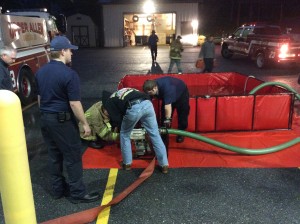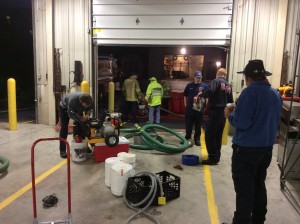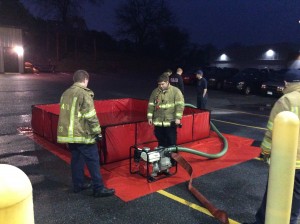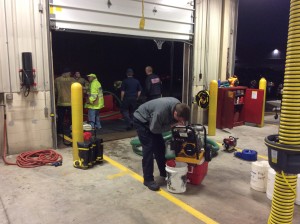Members for training night worked on checking equipment needed for possible flooding calls over the next couple of days.
Flooding Safety Tips
Turn Around, Don’t Drown
Flooding is the leading weather-related cause of death in the United States. Every year, almost as many people die from flooding as from hurricanes, tornadoes and lightning combined. Most flood-related deaths and injuries could be avoided if people who come upon areas covered with water followed this simple advice:
TURN AROUND, DON’T DROWN.
Inland flooding usually occurs during or after a heavy, slow-moving rain storm. But it also can result from strong coastal storms. Severe inland flooding can occur in areas that are hundreds of miles from the eye of a hurricane.
The reason that so many people drown during flooding is because few of them realize the incredible power of water. A mere six inches of fast-moving flood water can knock over an adult. It takes only two feet of rushing water to carry away a vehicle. This includes pickups and SUVs.
If you come to an area that is covered with water, you will not know the depth of the water or the condition of the ground under the water. This is especially true during the dark, when your vision is more limited.
Play it smart, play it safe. Whether driving or walking, any time you come to a flooded road, TURN AROUND DON’T DROWN!
Flash Floods
Inland flooding that leads to drowning usually occurs during flash-flood conditions.
Flash floods are those that develop within six hours of a rain storm. That may sound like a lot of time, but severe flash floods can occur in a matter of minutes, depending on the intensity and duration of the rain, the topography of an area, and the condition of the soil and ground cover.
Nearly half of all flash-flood fatalities are vehicle-related. The majority of victims are males, but flood deaths affect people of both sexes and all age groups.
Anyone who has witnessed a flash flood can testify to the devastating power of fast-rushing water. Flash floods can roll boulders, uproot trees, destroy buildings and bridges, carry away vehicles and create deep new channels in the earth. Rapidly rising water can reach heights of 30 feet or more. Rain storms that trigger flash floods can also cause catastrophic mud slides.
PREPARE FOR A FLOOD DISASTER IN ADVANCE
We may not be able to control weather conditions, but with only a little bit of planning, we can take all possible precautions to ensure our personal safety and protect our homes from severe damage. Here are some measures you can take to safeguard your home and family:
?Find out how vulnerable your home is to flooding by determining the elevation of your property.
?Evaluate your insurance coverage once a year to make sure your home is fully covered. As new construction grows in certain areas, more flood-plains are sometimes created.
?If your home is in a flood-prone area, contact the National Flood Insurance program to learn what mitigation measures you can take in advance.
?Contact your local emergency management agency to learn how to construct proper protective measures around your home.
?If you live in a flood-prone area, keep these materials on hand: sandbags, plywood, lumber, plastic sheeting, trash bags, shovels, work boots and gloves.
?Purchase a weather radio. These special, battery-operated radios cost as little as $20 and are available at many hardware and appliance stores and other retail outlets.
?Put together a disaster survival kit. Keep the following supplies near at hand and put them in a water-tight container: flashlight with extra batteries, battery-powered radio and weather radio, first aid kit, medicines, eyeglasses, drinking water, non-perishable foods, change of clothes, cash and credit cards, and copies of all important papers.
?Plan two evacuation routes in advance. Don’t wait until threatening weather conditions occur before trying to determine your route to safety. Be aware of streams, drainage channels and low areas in your region that are prone to flooding, so that your evacuation routes are not cut off.
?Do not park your vehicle near streams or rivers, especially during threatening weather conditions.
IF FLOODING OCCURS
Any time there is heavy rain in your area, be sure to follow these simple safety rules:
*Listen to NOAA Weather Radio for current and forecasted conditions in your area.
*If flooding begins in your area, go to higher ground immediately.
*When driving, always be aware that the road bed under flood waters may be severely damaged. NEVER drive through flooded roadways. Remember that it takes only two feet of water to carry away a vehicle, including pickups and SUVs.
*When walking, do not attempt to cross flowing streams. Remember that it takes only six inches of rushing water to knock an adult off his feet.
*If your vehicle stalls, get out immediately and go to higher ground.
*Be extra cautious at night, when it is harder to see possible flood dangers.
*These four words could save your life: TURN AROUND, DON’T DROWN.








You must be logged in to post a comment.